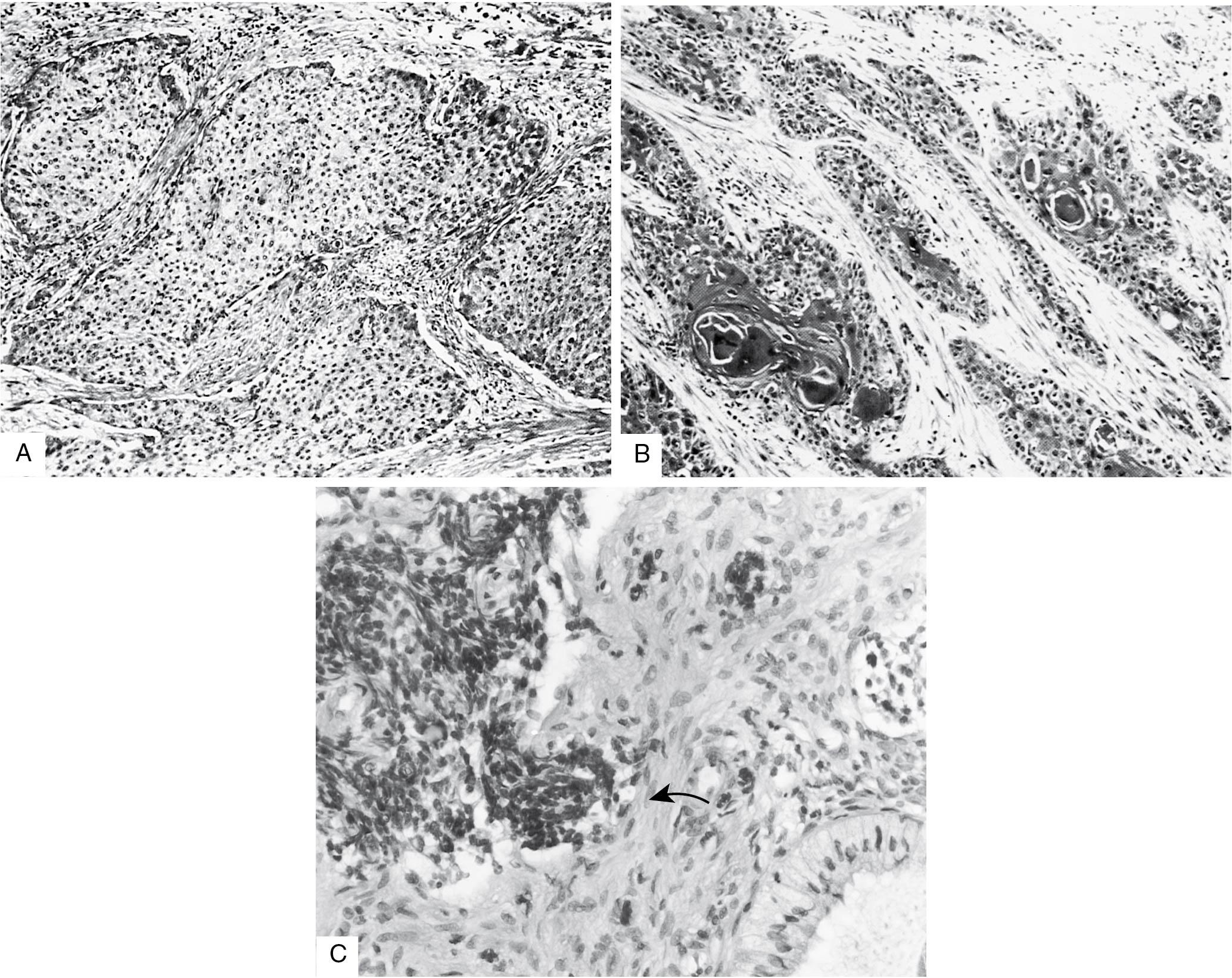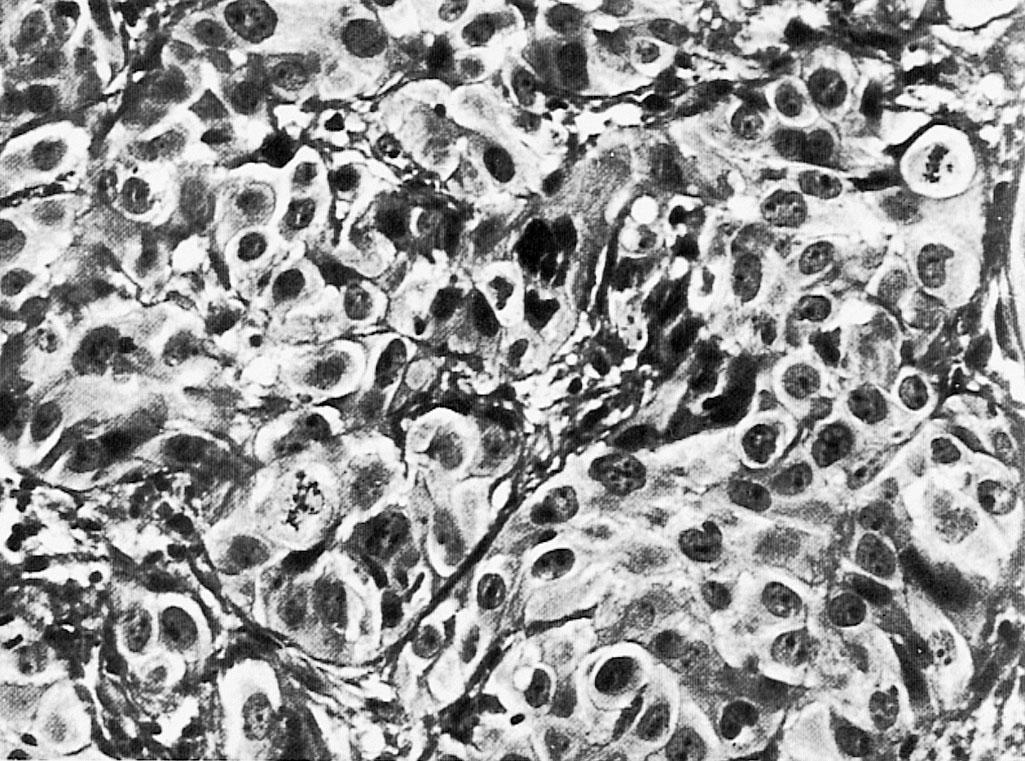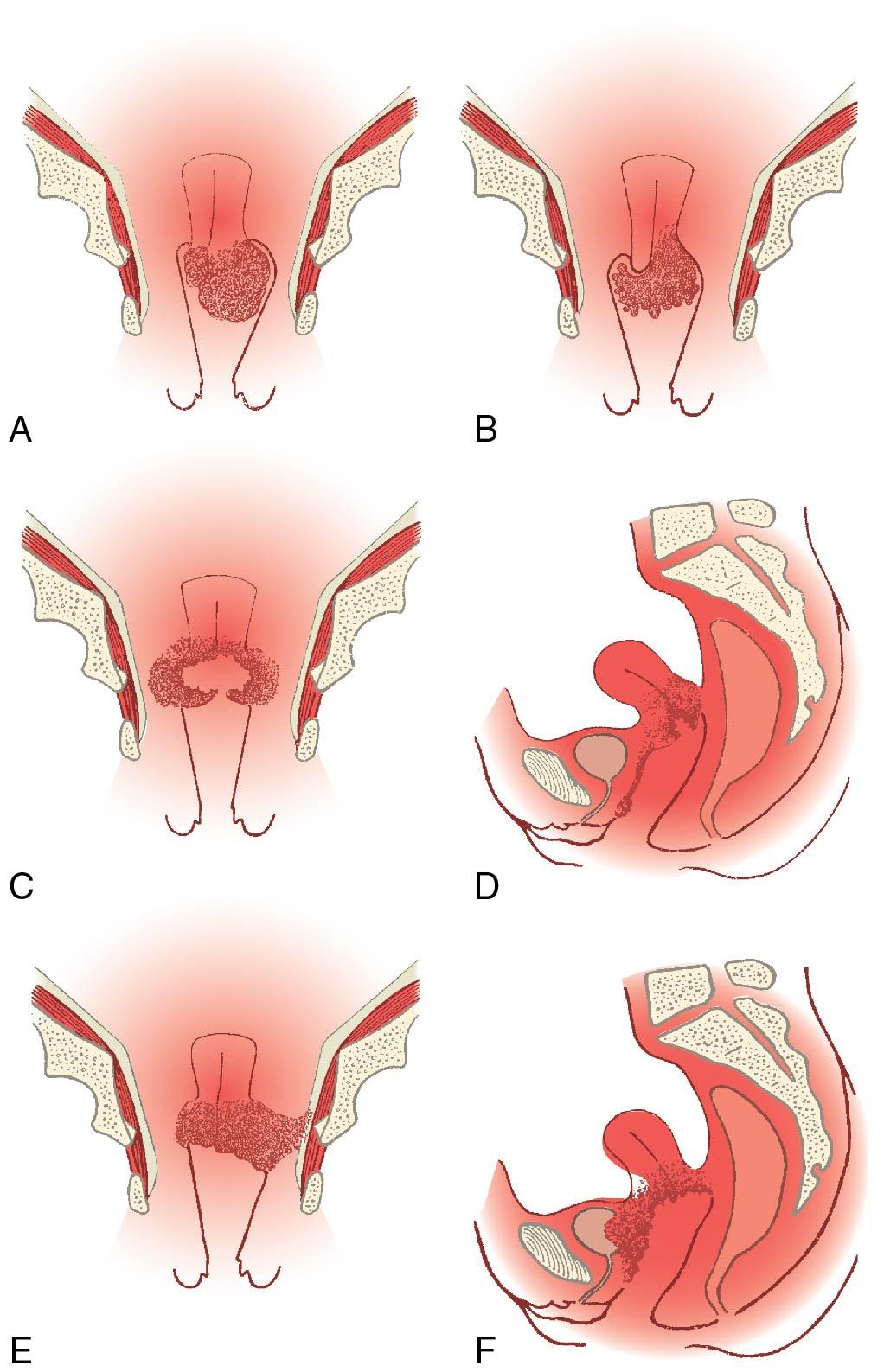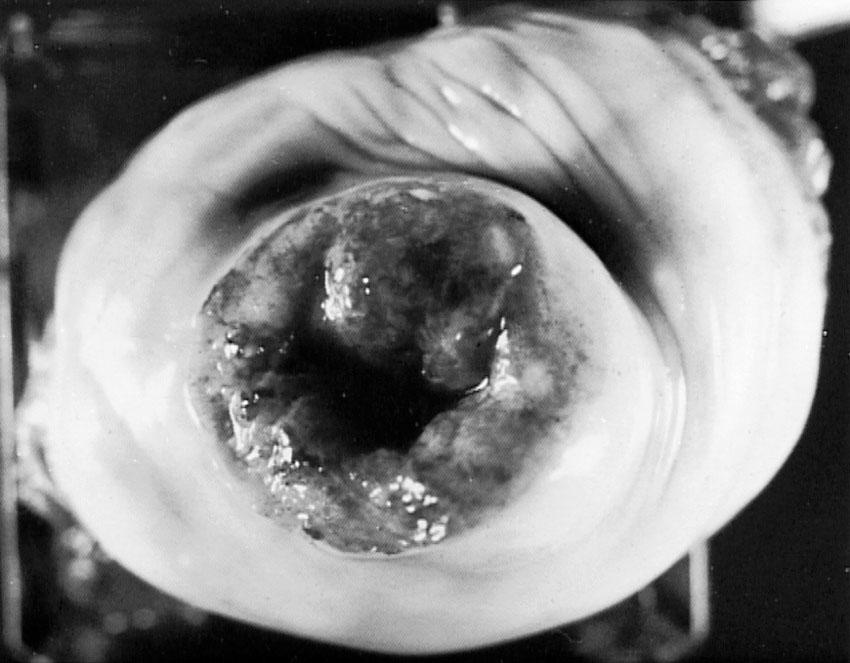Physical Address
304 North Cardinal St.
Dorchester Center, MA 02124
Carcinomas of the cervix are predominantly squamous cell carcinomas (85% to 90%), and approximately 10% to 15% are adenocarcinomas.
Squamous cell carcinomas are strongly associated with human papillomavirus (HPV) infection.
Cervical carcinoma is the third most common malignancy of the lower female genital tract, after endometrial and ovarian cancer, and the second most common cause of death, after ovarian cancer.
Definitive diagnosis of microinvasive carcinoma is established only by means of cervical conization, not biopsy. The margins of the cone should be free of neoplastic epithelium before conservative therapy is undertaken.
Microinvasive carcinoma of the cervix can be effectively treated by total hysterectomy, with a 5-year survival rate of almost 100%, but recurrent neoplasia can develop after 5 years; however, a precise and reliable definition of microinvasion is controversial.
Prognosis in squamous cell cancer of the cervix is related to tumor stage and lesion size, depth of invasion, and spread to lymph nodes.
Cervical carcinomas are locally invasive tumors that spread primarily to the pelvic tissues and then to the pelvic and paraaortic lymph nodes. Less commonly, hematogenous spread to the liver, lung, and bone occurs.
The risk of the spread of cervical carcinoma to pelvic nodes is approximately 15% for stage I, 29% for stage II, and 47% for stage III. For the paraaortic nodes, the figures are 6% for stage I, 19% for stage II, and 33% for stage III.
Surgery is often used to treat stage IB and early stage IIA carcinomas of the cervix, particularly for smaller tumors and in younger patients to preserve their ovarian function. Surgery produces less scarring and vaginal fibrosis than radiation and is preferred for women with a pelvic infection or a history of conditions such as inflammatory bowel disease, which increase the risk for radiation complications.
Minimally invasive radical hysterectomies are associated with increased rates of recurrence and decreased survival rates compared with an open abdominal surgical approach.
High-stage tumors are treated by chemoradiation. Programs usually use cisplatin, 40 mg/m 2 weekly, during external treatment and with brachytherapy.
Most cancers of the cervix are treated by radiation therapy (teletherapy and brachytherapy). Radiation doses vary with tumor size and stage but are approximately 50 to 65 Gy at point B and 80 to 85 Gy at point A. Brachytherapy should be used whenever feasible because data indicate that use of brachytherapy improves survival compared with any other type of modality.
Complications after radiation are related to dose and volume of tissue treated; these include radiation inflammation of the bladder or bowel, which may lead to pain, bleeding, or, infrequently, fistula formation. The normal cervix is resistant to radiation, and the dose can be as high as 200 to 250 Gy over 2 months. The rectum should be limited to doses of 70 Gy or less and the bladder to doses of 80 Gy or less. Overall, the rate of moderate to severe radiation complications for treatment of all stages is approximately 10%.
Worldwide 5-year survival rates reported for patients with carcinomas of the cervix are as follows: stage IA, 95%; stage IB, 80%; stage II, 70%; stage III, 50%; and stage IV, 20% with radiation therapy alone.
Pregnancy does not adversely affect the survival rate for women with carcinoma of the cervix, stage for stage.
Approximately one-third of patients treated for cervical carcinoma develop tumor recurrence, and approximately 50% of these recurrences are located in the pelvis; most occur within 2 years.
Patients whose recurrences occur more than 3 years after primary therapy have a better prognosis than those with earlier recurrence.
Pelvic exenteration in carefully selected patients with central pelvic recurrence can lead to a 5-year survival rate of 50% or better.
Chemotherapy of recurrent squamous cell carcinoma of the cervix does not produce long-term cures, but results suggest that cisplatin-paclitaxel-bevacizumab should be considered the standard treatment for patients with stage IVB recurrent or metastatic cervix cancer.
The majority of cervical malignancies are carcinomas; a summary of the more common histologic types is shown in Box 31.1 . Approximately 80% to 85% of these tumors are squamous cell carcinomas, and 15% to 20% are adenocarcinomas. The incidence of adenocarcinomas has increased in most developing countries, particularly among younger women. Carcinoma of the cervix is closely associated with early and frequent sexual contact and cervical viral infection, particularly human papillomavirus (HPV), as detailed in Chapter 29 . According to the American Cancer Society, the frequency of cervical cancer has been steadily decreasing, in part because of the effect of widespread screening for premalignant cervical changes by cervical cytologic testing (Papanicolaou [Pap] smear). In the United States there will be an estimated 13,240 new cases of invasive cervical cancer diagnosed in 2018, with 4170 related deaths ( ). Racial and ethnic disparities continue in the United States in both the incidence and mortality from cervical cancer. The incidence of cervical carcinoma in the United States is higher among the Hispanic population (9.7 per 100,000) compared with white (7 per 100,000) and African American populations (9.5 per 100,000) ( ); however, the mortality rate from cervical cancer is the highest among African Americans compared with other races and ethnicities, partly because African Americans tend to be diagnosed at a later stage. Invasive cervical cancers are diagnosed at a localized stage in 47% of white women and 37% of African American women. This chapter details the various types of cervical carcinoma and considers the natural history, methods of diagnosis and evaluation, and details of therapy. Primary sarcomas and melanomas of the cervix are extremely rare and are not considered separately.
Varieties of squamous cell carcinoma of the cervix are illustrated in Fig. 31.1 . An early form, microinvasive carcinoma, is considered separately in the next section. Most squamous cell carcinomas of the cervix are reported to be of the large cell, nonkeratinizing type, but some are keratinized, and squamous pearls may be seen. The degree of differentiation of the tumors is usually designated by three grades: G1, well differentiated; G2, intermediate; and G3, undifferentiated; however, there is no consensus on the value of tumor grade as a major prognostic factor for squamous cell carcinoma of the cervix.

A rare variety of squamous cell carcinoma is the so-called verrucous carcinoma, which is morphologically similar to that found in the vulva (see Chapter 30 ). These warty tumors appear as large bulbous masses ( Fig. 31.2 ). They rarely metastasize but unfortunately may be admixed with the more virulent, typical squamous cell carcinomas, in which case metastatic spread is more likely.

Adenocarcinomas may have a number of histologic varieties. The typical variant often contains intracytoplasmic mucin and is related to the mucinous cells of the endocervix (endocervical pattern; Fig. 31.3 ); however, on occasion the cells contain little or no mucin, and then the tumor may resemble an endometrial carcinoma (endometrioid pattern). It may be difficult histologically to ascertain whether these carcinomas arise in the cervix or endometrium. Although not independently diagnostic, the immunohistochemical panel that is recommended to assist in differentiating endocervical from endometrial primary malignancies includes estrogen receptor (ER), vimentin, monoclonal carcinoembryonic antigen (CEA), and p16. Typically an endocervical carcinoma stains diffusely positive for p16 and CEA and is negative for ER and vimentin.

A rare but important virulent variety of adenocarcinoma is adenoma malignum. These microscopically innocuous-appearing tumors consist of well-differentiated mucinous glands ( Fig. 31.4 ) that vary in size and shape and infiltrate the stroma. Despite their bland histologic appearance, they tend to be deeply invasive and metastasize early. The term minimal deviation adenocarcinoma is applied to these tumors.

Clear cell adenocarcinomas of the cervix are histologically identical to those of the ovary (see Chapter 33 ) and vagina (see Chapter 30 ). They are uncommon in the cervix and can be associated with intrauterine diethylstilbestrol exposure, although they also may develop spontaneously in the absence of diethylstilbestrol exposure.
Adenoid cystic carcinomas are rare. Berchuk and Mullin summarized 88 cases reported in the literature ( ). These tumors are aggressive and may resemble cylindromas of salivary gland or breast origin and histologically may resemble basal cell carcinomas of the skin (adenoid basal, or basaloid, carcinomas). Most patients with these tumors are older than 60 years. The basaloid variety appears to be less aggressive.
Adenosquamous carcinomas, as the name implies, consist of squamous carcinoma and adenocarcinoma elements in varying proportions ( Fig. 31.5 ). They occur often in pregnant women. A particularly virulent variety is termed glassy cell carcinoma ( Fig. 31.6 ). This is an undifferentiated tumor consisting of large cells containing cytoplasm, with a ground-glass appearance. Glassy cell carcinomas tend to metastasize early to lymph nodes and to distant sites and usually have a fatal outcome.


Small cell carcinoma of the cervix is rare, comprising less than 5% of all carcinomas of the cervix. Women with small cell carcinoma are likely to be 10 years younger than those with squamous cell carcinoma. Cervical small cell carcinoma is composed of small anaplastic cells with scant cytoplasm that behave aggressively and are often associated with widespread metastasis to multiple sites, including bone, liver, skin, and brain. Efforts to treat these cancers with approaches typically used for small cell carcinoma of the lung have had mixed results.
Another variant that is not in the World Health Organization (WHO) classification is non–small cell neuroendocrine tumors. These tumors contain intermediate to large cells, high-grade nuclei, and eosinophilic cytoplasmic granules of the type seen in neuroendocrine cells. Reported survival rates for patients with these aggressive carcinomas are similar to those of patients with small cell tumors, and an optimal therapy has yet to be established.
Patients with carcinoma of the cervix characteristically present with abnormal bleeding or brownish discharge, often noted after douching or intercourse and also occurring spontaneously between menstrual periods. These patients often have a history of not having had a cytologic (Pap) smear for many years. Other symptoms, such as back pain, loss of appetite, and weight loss, are late manifestations and occur when there is extensive spread of cervical carcinoma. The patients tend to be in their 40s to 60s, with a median age of 52 years. Preinvasive intraepithelial carcinoma of the cervix (see Chapter 29 ) occurs primarily in women in their 20s and 30s and has become more common in those in their 20s, leading to a gradual increase in the incidence of invasive carcinoma in younger patients.
The diagnosis is established by biopsy of the tumor; a specimen can easily be obtained during an office examination. A Kevorkian, Eppendorf, Tischler, or similar punch biopsy instrument is convenient to use. Occasionally it is necessary to biopsy nodularity or indurations in the vagina near the cervix to ascertain the limit of tumor spread and define a correct tumor stage. If the woman’s cytologic smear suggests invasive carcinoma, with no gross lesion visible, and endocervical curettage does not demonstrate carcinoma, or if an adequate biopsy specimen to establish carcinoma cannot be obtained, cervical conization should be performed.
Historically the staging of carcinoma of the cervix depended primarily on the pelvic examination, with no changes to staging based on operative findings. In 2018, the staging system underwent revisions that allow imaging and pathologic findings from surgery, where available, to assign the stage. Table 31.1 describes the four stages of cervical carcinoma according to the International Federation of Gynecology and Obstetrics (FIGO; revised in 2018) ( ). The types of tumor distributions that may be observed in the various stages are illustrated in Fig. 31.7 .
| Stage | Characteristics |
|---|---|
| I | Carcinoma is strictly confined to the cervix (extension to the corpus should be disregarded) |
| IA | Invasive cancer that can be diagnosed only by microscopy, with deepest invasion <5 mm * |
| IA1 | Measured stromal invasion <3 mm in depth |
| IA2 | Measured stromal invasion of ≥3 mm and <5 mm in depth |
| IB | Invasive carcinoma with measured deepest invasion ≥5 mm (greater than stage IA), lesion limited to the cervix uteri † |
| IB1 | Invasive carcinoma >5 mm depth of stromal invasion, and ≤2 cm in greatest dimension |
| IB2 | Invasive carcinoma >2 cm and ≤4 cm in greatest dimension |
| IB3 | Invasive carcinoma lesion >4 cm in greatest dimension |
| II | The carcinoma invades beyond the uterus, but has not extended onto the lower third of the vagina or to the pelvic wall |
| IIA | Involvement limited to the upper two-thirds of the vagina without parametrial involvement |
| IIA1 | Invasive carcinoma <4 cm in greatest dimension |
| IIA2 | Invasive carcinoma mensionn greatest dimension |
| IIB | With parametrial involvement but not up to the pelvic wall |
| III | The carcinoma involves the lower third of the vagina and/or extends to the pelvic wall and/or causes hydronephrosis or nonfunctioning kidney and/or involves pelvic and/or paraaortic lymph nodes ‡ |
| IIIA | The carcinoma involves the lower third of the vagina, with no extension to the pelvic wall |
| IIIB | Extension to the pelvic wall and/or hydronephrosis or nonfunctioning kidney (unless known to be due to another cause) |
| IIIC | Involvement of pelvic and/or paraaortic lymph nodes, irrespective of tumor size and extent (with r and p notations) ‡ |
| IIIC1 | Pelvic lymph node metastasis only |
| IIIC2 | Paraaortic lymph node metastasis |
| IV | The carcinoma has extended beyond the true pelvis or has involved (biopsy-proven) mucosa of the bladder or rectum; a bullous edema, as such, does not permit a case to be allotted to stage IV |
| IVA | Spread to adjacent pelvic organs |
| IVB | Spread to distant organs |
* Imaging and pathologic examination can be used, where available, to supplement clinical findings with respect to tumor size and extent, in all stages.
† The involvement of vascular/lymphatic spaces does not change the staging. The lateral extent of the lesion is no longer considered.
‡ Adding notation of r (imaging) and p (pathology) to indicate the findings that are used to allocate the case to stage IIIC. Example: If imaging indicates pelvic lymph node metastasis, the stage allocation would be stage IIIC1r, and if confirmed by pathologic findings, it would be stage IIIC1p. The type of imaging modality or pathology technique used should always be documented.

Carcinoma of the cervix is initially a locally infiltrating cancer that spreads from the cervix to the vagina and paracervical and parametrial areas. Grossly the tumors may be ulcerated ( Fig. 31.8 ), similar to carcinomas occurring elsewhere in the female genital tract, and may have an exophytic growth pattern or cauliflower-like appearance extruding from the cervix. Alternatively, they may be endophytic, in which case they are asymptomatic, particularly in the early stage of development, and tend to be deeply invasive when diagnosed. These usually start initially from an endocervical location and often fill the cervix and lower uterine segment, resulting in a barrel-shaped cervix. The latter tumors tend to metastasize to regional pelvic nodes and, because of the tendency of late diagnosis, are often more advanced than the exophytic variety. The primary path for distant spread is through lymphatics to the regional pelvic nodes. Bloodborne metastases from cervical carcinomas do occur but are less common and are usually seen late in the course of the disease.

Initially, cervical carcinoma spreads to the primary pelvic nodes, which include the pericervical node; presacral, hypogastric (internal iliac), and external iliac nodes; and nodes in the obturator fossa near the vessels and nerve. From this primary group, tumor spread proceeds secondarily to the common iliac and paraaortic nodes. Rarely the inguinal nodes are involved; however, if the lower third of the vagina is involved, the median inguinal nodes should be considered primary. The distribution of lymph node involvement in 26 cases of untreated carcinoma of the cervix was studied in detail by Henriksen ( Fig. 31.9 ) ( ). A series studying the incidence and distribution pattern of retroperitoneal lymph node metastases in 208 patients with stages IB, IIA, and IIB cervical carcinomas who underwent radical hysterectomy and systemic pelvic node dissection reported that 53 patients (25%) had node metastasis ( ). The obturator lymph nodes were the most commonly involved, with a rate of 19% (39 of 208), and the authors proposed them as sentinel nodes for cervical cancers. An important distal node that becomes involved after the paraaortic group is the left scalene node—that is, the left supraclavicular node. A biopsy of this node may be performed in the assessment of advanced cervical carcinoma to clarify whether the tumor has spread outside the abdomen. In addition to nodal spread, hematogenous spread of cervical carcinoma occurs primarily to the lung, liver, and, less often, bone (see Recurrence later in the chapter).

FIGO stage is the most important determinant of prognosis for carcinoma of the cervix ( Table 31.2 ); however, there are other factors, including tumor and patient characteristics, that are prognostic. One of the most important predictors is tumor size for local recurrence and death for patients treated with surgery or radiation therapy ( ). The 2018 FIGO staging classification for stage IB disease was further modified based on tumor diameter (i.e., IB1, <2 cm; IB2, ≥2 cm and <4 cm; and IB3, ≥4 cm). Another important prognostic factor is involvement of lymph nodes, which is now included in the staging system as stage IIIC disease. In several surgical series, after a radical hysterectomy, patients with positive pelvic lymph nodes had a 35% to 40% lower 5-year survival rate than patients with negative nodes. Patients with positive paraaortic nodes have a survival rate that is approximately 50% that of patients with similar stage disease and negative paraaortic nodes. With extended-field radiation therapy, patients with positive paraaortic nodes have approximately a 40% to 50% 5-year survival rate. There is a strong correlation between positive nodes and positive lymph–vascular space invasion (LVSI) in the tumor specimen in patients with cervical carcinoma; however, LVSI may be an independent predictor of prognosis, as shown in a number of larger surgical series.
| Stage | No. of Patients (n) | 5-Year Survival |
|---|---|---|
| IA | 902 | 95.01% |
| IB | 4657 | 80.1% |
| II | 3364 | 64.2% |
| III | 2530 | 38.31% |
| IV | 492 | 14% |
In patients who have had a radical hysterectomy, histologic evidence of extracervical spread (≥10 mm), deep stromal invasion (>70% invasion), and LVSI are associated with a poorer prognosis. A randomized trial from the Gynecologic Oncology Group (GOG) compared observation versus adjuvant radiation therapy in patients after radical hysterectomy with a combination of two of the factors mentioned earlier; patients who received radiation therapy had better local control and improved overall survival ( ). Involvement of the parametrium in the hysterectomy specimen has been correlated with higher rates of lymph node involvement, local recurrence, and death from cancer. Uterine body involvement is associated with an increased rate of distant metastases in patients treated with radiation or surgery.
Patients with adenocarcinomas of the cervix have a poorer prognosis than patients with squamous cell carcinomas of the cervix. Investigators have found that among patients treated surgically, patients with adenocarcinomas have high relapse rates compared with rates in patients with squamous cell carcinomas. In an analysis of 1767 patients treated with radiation for FIGO stage IB disease, Eifel and associates found that independent of age, tumor size, and tumor morphology, patients with adenocarcinomas had the same pelvic control rate but twice as high a rate of distant metastasis as patients with squamous cell carcinomas of the cervix ( ). Although the prognostic significance of histologic grade for squamous carcinomas has been disputed, there is a clear correlation between the degree of differentiation and the clinical behavior of adenocarcinomas.
There has been a great interest in molecular markers for prognosis and treatment in carcinoma of the cervix. One of the most studied markers is the serum squamous cell carcinoma antigen. Studies have shown that pretreatment levels of this antigen correlate well with stage of disease, tumor histologic characteristics, grade, type of tumor (exophytic vs. infiltrative), microscopic depth of invasion, and risk of lymph node metastases in patients with early-stage disease. Possible clinical applications of this antigen may be to predict clinical outcome and as a marker for monitoring the course of disease and response to treatment in patients with cervical cancer. Several investigators have reported significantly lower survival rates in patients with elevated values compared with patients with normal baseline levels, independent of stage. For detection of tumor recurrence, serial squamous cell carcinoma antigen testing has proved to be more specific than sensitive, with specificities ranging from 90% to 100% and sensitivities ranging from 60% to 90%. Further investigation is needed in these areas. Some investigators have found a higher rate of recurrence in patients with HPV-positive nodes (although negative for malignancies) and poor prognosis with the presence of HPV messenger RNA (mRNA) in the peripheral blood of cervical cancer patients. Other markers that have been investigated include epidermal growth factor receptor, cyclooxygenase-2, DNA-ploidy, tumor vascularity, and S-phase fraction. Programmed death ligand 1 (PDL1) expression may be useful for treatment decisions in the recurrent setting ( ).
Once a woman has been diagnosed as having an invasive carcinoma, a pretreatment evaluation is conducted to determine the extent of disease, arrive at an accurate clinical staging, and plan the program of therapy. The usual evaluation consists of a thorough history and physical examination, routine blood studies, intravenous pyelogram (IVP) or computed tomography (CT), and chest radiography. Demonstration of an obstructed ureter or nonfunctioning kidney caused by tumor automatically assigns the case at least to stage III (see Table 31.1 ). A barium enema test or flexible sigmoidoscopy, as well as a cystoscopy, is sometimes performed in the case of large tumors or for patients who will be receiving radiation treatment.
The best radiographic imaging technique for detecting lymph node metastases is unclear. CT and magnetic resonance imaging (MRI) are good for identifying enlarged nodes; however, the accuracy of these techniques in the detection of positive nodes is compromised by their failure to detect small metastases, and many enlarged nodes are caused not by metastases but by inflammation associated with advanced disease. The accuracy of MRI in the detection of lymph node metastases (72% to 93%) is similar to that of CT but better than CT and physical examination for the evaluation of tumor location, tumor size, depth of stromal invasion, vaginal extension, and parametrial extension of cervical cancer; however, with regard to detecting lymph node metastases or other distant disease, positron emission tomography (PET) shows promise. Several studies from a single institution have shown that 18 F-fluorodeoxyglucose PET (FDG-PET) detects abnormal lymph nodes more often than CT, and those findings with PET are a better predictor of survival than those with CT or MRI in patients with carcinoma of the cervix. Medicare has approved PET/CT as part of the initial staging evaluation for patients with cervical carcinoma, and most insurance companies approve PET/CT for a 3-month follow-up.
Surgical sampling of lymph nodes is the most sensitive method of evaluating whether regional lymph nodes contain metastases; however, it is invasive, expensive, and may delay treatment of the primary lesion. Laparoscopic lymph node dissection may decrease the time between surgery and the start of treatment and may be associated with less late radiation-related morbidity than open transperitoneal staging. Laparoscopic extraperitoneal paraaortic lymphadenectomy has also been described and may further decrease radiation-related bowel morbidity by avoiding entrance into the peritoneal cavity. In a study by Ramirez and colleagues, 22% of patients who had positive pelvic but negative paraaortic nodes on PET/CT had histopathologically positive paraaortic nodes ( ).
Become a Clinical Tree membership for Full access and enjoy Unlimited articles
If you are a member. Log in here